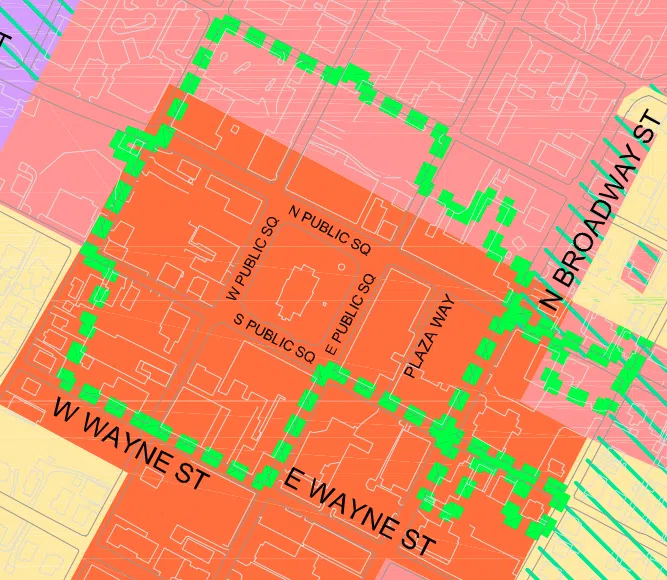
The dotted green line is Glasgow's Public Square historic district, according to the city's zoning map.
By MICHAEL CRIMMINS
Glasgow News 1
Members of Glasgow’s Historic Preservation Commission discussed different ways to highlight the city’s historic downtown district at its recent meeting.
Commission Chair Tim Gooden brought up the seeming lack of public knowledge regarding the bounds of the historic district when mentioning that he had called the man that had bought the Esters Building. The building is on South Race Street next to the old Barren County Schools Board of Education building.
“He was a little surprised to get a call for me,” Gooden said. “My first question was ‘did anybody relay to you during the sale that you would be obligated [to go to the committee for their approval on external changes] and he said ‘no’…. I wish there was some way that we could get information out to all the real estate companies or some way to get attached [to the property] that if you’re buying or selling a building in the historic district then people are aware of the historic preservation commission and what we do.”
“I wonder if we could talk to the PVA office and get some kind of tag put on [historic properties] in their system,” Commissioner Thomas Grubbs said.
Glasgow’s Public Square Historic District was created in 2004. A historic district is “a designated area within a city … that contains buildings and structures recognized for their historical significance,” according to U.S. Legal Forms. Structures within this defined district usually have to adhere to more stringent regulation “typically involv[ing] local preservation ordinances or zoning laws that are tailored to protect the character of the designated area” and are subject to more oversight.
“[O]rdinances regulate the construction, demolition, and alteration of buildings within the district to ensure that new work or changes are compatible with the area’s historical character,” the Kentucky Heritage Council states. “The local government, through a historic preservation commission, has authority over exterior alterations to buildings within the district. While it can place certain restrictions on property owners, it helps safeguard the area’s historical value for future generations, offering benefits such as cultural enrichment, enhanced property values, and potential financial incentives.”
Commissioners Wagner and Mike Darnell mentioned a desire to highlight the district in a positive way and dispel the perception that locating in a historic district is burdensome without benefit, noting the various improvements made to buildings downtown.
“It seems most people have a negative connotation of historic districts, and I don’t know the stories they’ve heard…where you can’t do anything without getting it approved, and that may be true in some cities, but it’s not [here],” Darnell said. “The fact that you can do whatever you want inside…is better than the stories everybody wants to tell.”
“Maybe we need to do some presentation to make [the historic district] a desirable thing,” Wagner said. “Show the improvements that have come in this district in the last few years.”
No set course of action was decided by the commissioners. Gooden said he would get in contact with Glasgow city attorney Rich Alexander “to see what [they] could do,” and commissioner Beth Wagner suggested the possibility of doing presentations to the realtors to increase awareness of the district.
Comments